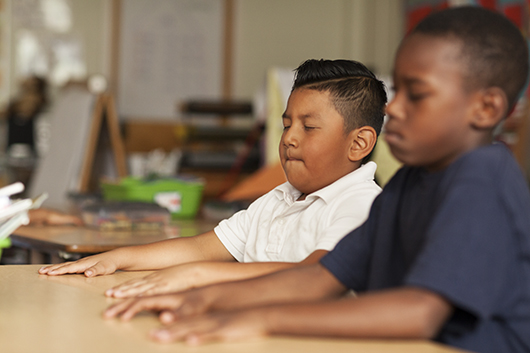
It was right after recess, and first-graders were lining up to go back to their classrooms when a student accidentally pushed a little girl. She fell and started to cry — a perhaps not unusual happening among rambunctious children everywhere. But what followed certainly was.
One of her fellow students came over to her. “You’ll be OK,” he said. “Just breathe. And count.” And the little girl did.
Aurora Guzman, a first-grade teacher at Florence Griffith Joyner Elementary School in Watts who witnessed this scene, was astonished to see how the girl calmed herself.
“And I said to myself, this is exciting,” Guzman says. “She was using the skills we’d learned in the classroom.”
What skills? Certainly not the usual. Joyner first-graders are doing breathing and counting relaxation exercises — mind-body techniques introduced to them through the Calm Classroom program. Calm Classroom was brought to Joyner last fall by UCLA’s Center for Child Anxiety Resilience Education and Support (CARES), part of the Department of Child and Adolescent Psychiatry.
Calm Classroom techniques, which are based on studies done in the 1990s at Harvard Medical School, were first practiced in Chicago-area schools with materials developed by the not-for-profit Luster Learning Institute. The techniques, which help students become calmer and more “mindful,” are now used in more than 200 K-12 schools, mostly in the Midwest. The Calm Classroom practice fosters an improved learning environment, which is especially important in schools where children are already anxious because of difficult home or community circumstances.
After successfully rolling out Calm Classroom in UCLA’s own Lab School in the 2015-16 academic year, CARES took it into some Los Angeles Unified School District schools.
CARES is starting with schools like Joyner that are engaged in the Partnership for L.A. Schools program, which focuses on the district’s highest-need schools. Joyner is the first CARES-affiliated public school in California to implement Calm Classroom.
“We hope to do this with all of L.A.’s Partnership schools,” says John Piacentini, CARES director. “It leads to a more positive kind of environment, both in the classroom and even the entire school, over time. That’s our goal at CARES — to do something that has a broader impact on the school milieu as a whole.”
Piacentini says that Calm Classroom is easy to implement. Teachers need only a few hours of training, much of it focusing on the science behind the techniques. They choose specific kinds of exercises from a manual. Typically, they engage students at the beginning of the school day or at other key times, such as after recess or lunch.
“It’s then we need them to focus instead of being all wiggly and talkative,” Guzman says of her first-graders. “I’ve seen a large difference in the way the students transition to a learning activity.”
Author: Claudia Luther
Source publication: UCLA Magazine